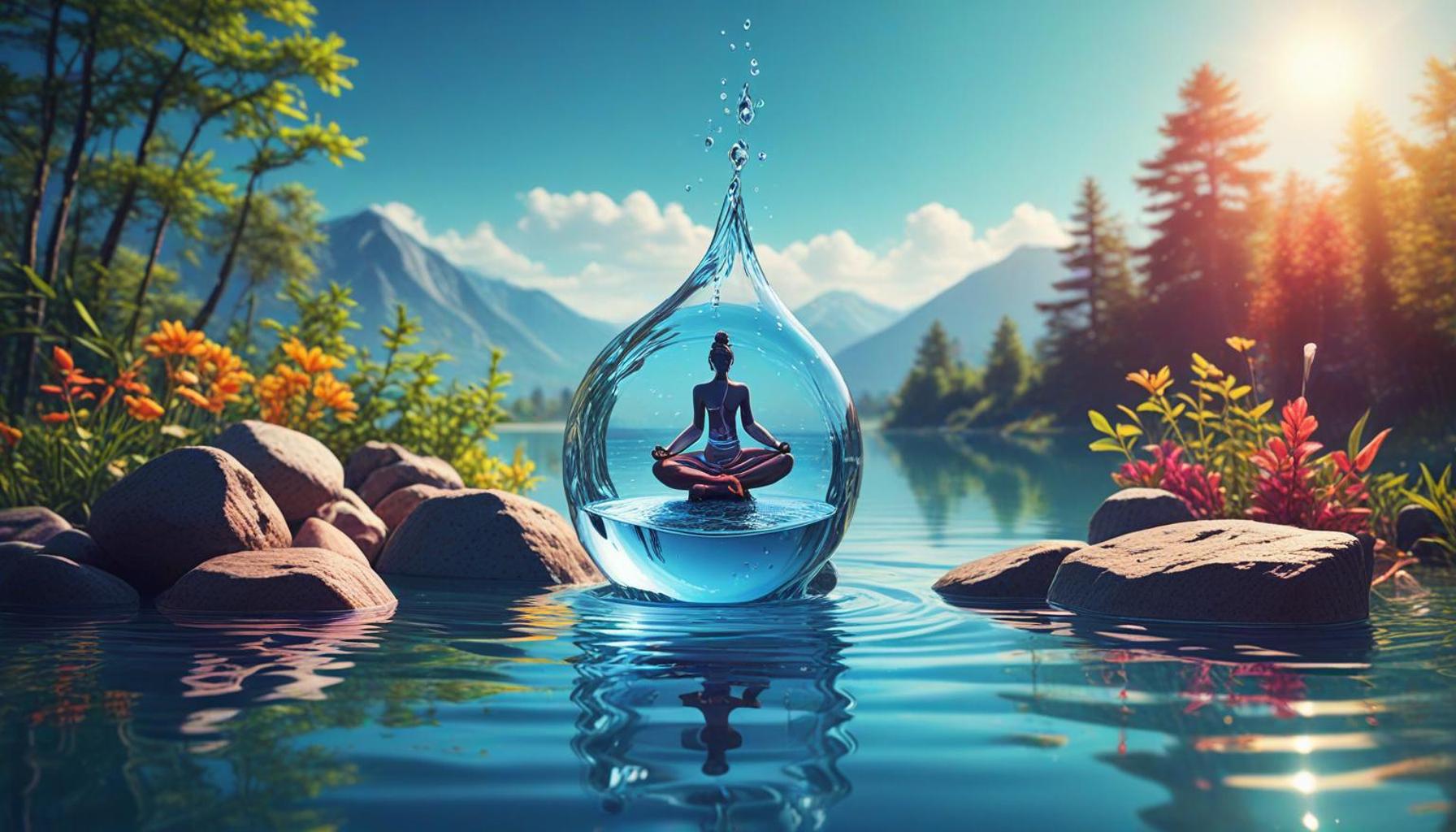The Influence of Water Temperature on the Meditation Experience: Finding the Ideal Balance for Relaxation

The Impact of Water Temperature on Meditation
Meditation is often regarded as a sanctuary for the mind, a tranquil reprieve that fosters relaxation and mental clarity. Yet, an essential aspect that is frequently overlooked is the water temperature in which practitioners choose to immerse themselves. This element can profoundly affect both physical comfort and mental tranquility, potentially transforming an ordinary meditation session into an extraordinary one.
Comfort Level
The sensation of water wraps around the body like a gentle embrace, and its temperature can significantly influence how one feels during meditation. For instance, warm water is celebrated for its ability to relax muscles and soothe tension, making it a preferred choice for many seeking a deeper state of relaxation. In the early morning or late evenings in Nigeria, when the air is slightly cooler, warm baths can enhance relaxation and create a cocoon effect, encouraging a sense of safety and comfort.
Conversely, cool water can invigorate the senses, providing a refreshing shock that sharpens focus and enhances mental clarity. This is especially beneficial in the sweltering heat typical of many Nigerian cities, where a dip in a cool river or pool can revive the mind and prepare it for a productive meditation session.
Physical Reactions
Different water temperatures trigger unique physical reactions that can affect meditation outcomes. Warm water tends to increase blood circulation, helping to alleviate stress and promote relaxation. On the other hand, exposure to cool water can stimulate the body to produce adrenaline, which can lead to heightened alertness. For those practicing meditation outdoors, such as by the beautiful rivers of the Niger or near the serene beaches of Lagos, understanding these responses can guide them in choosing an appropriate temperature for their goals.
Mental State Enhancement
The sensory experience of water plays a crucial role in mindfulness. In warm water, the gentle warmth envelops the body like a hug, allowing practitioners to delve deeper into their thoughts and emotions. By contrast, the tactile sensations of cool water can increase awareness, prompting a more active engagement with the present moment. Both experiences can enhance mindfulness, but the ideal temperature can vary based on individual preferences and climatic conditions.

Cultural Context in Nigeria
In Nigeria, where cultural practices often intersect with spirituality, many individuals seek out natural water bodies such as the majestic River Niger or local pools to meditate. Choosing the right water temperature is a nuanced decision often influenced by what feels comfortable and energizing to the individual. These natural settings not only provide a refreshing oasis but also enable a deeper connection with nature and oneself.
As practitioners explore the relationship between water temperature and meditation, it is essential to consider their personal preferences and the environmental context. By experimenting with different temperatures, one can discover what resonates best, fostering an enriched state of relaxation and inner peace. From anecdotal experiences shared among communities to scientific findings on the body’s reactions, this exploration can lead to profound insights that deepen one’s meditative practice.
LEARN MORE: This related article may interest you
Understanding the Role of Water Temperature in Meditation
As practitioners delve into the nuances of meditation, the significance of water temperature emerges as a topic worthy of exploration. The water surrounding the body creates a unique sensory experience that can greatly influence the overall meditation practice. To truly harness the benefits of meditation, one must consider how various temperatures affect both the mind and body.
Physical Comfort and Emotional Connection
Physical comfort is paramount to engaging in a successful meditation experience. Practicing meditation in warm water can induce feelings of safety and comfort that complement the mental focus required for meditation. This soothing element can lead to the following benefits:
- Muscle Relaxation: Warm water helps to relieve tension in the body, allowing for deeper breathing and relaxation of the mind.
- Stress Relief: The heat promoted by warm water can reduce cortisol levels, the hormone associated with stress, fostering a calmer mental state.
- Enhanced Circulation: Improved blood flow can lead to a sense of vitality that enhances endurance during meditation sessions.
Conversely, cool water can evoke a sense of alertness that invigorates the mind, helping to sharpen concentration. For practitioners in Nigeria, where the climate can be tropical and humid, a refreshing bath in cool water can energize the body and fuel motivation for meditation. The following attributes illustrate the advantages of practicing meditation in cool water:
- Increased Alertness: As the body responds to cooler temperatures, the mind becomes more engaged, allowing for greater intellectual curiosity.
- Heightened Focus: The cool sensation can trigger enhanced cognitive functions, making it easier to concentrate on meditative practices.
- Refreshing Rejuvenation: Cool water can recharge the body’s immune system, providing a natural boost of energy.
Mindfulness and Sensory Awareness
The meditative process involves not only the physical aspect but also a state of mindfulness that can be profoundly impacted by water temperature. When immersed in warm water, the experience may facilitate a deeper introspection, creating a barrier from external distractions. This immersion prompts practitioners to become acutely aware of their thoughts and emotions. In contrast, the sensation of cool water can add a layer of sensory engagement that heightens the experience of being present in the moment.
Furthermore, cultural practices in Nigeria reflect the importance of nature in fostering meditative states. Many practitioners embrace the local rivers or serene shorelines to create a connection with their surroundings. By attuning themselves to the variations of water temperature, individuals can enhance their meditative practice, aligning with personal preferences and the environmental context. Ultimately, the relationship between water temperature and meditation is an intricate balance worth exploring, as it invites practitioners to discover a state of relaxation unique to their experiences.
The Role of Water Temperature in Enhancing Meditation
Water temperature plays a critical role in shaping the overall meditation experience. Warm water has a calming effect on the body, helping to ease muscle tension and release physical stress, allowing practitioners to focus on their breath and thoughts. The soothing sensation provided by warm water can create a serene atmosphere, enhancing the connection between the body and the mind during meditation.Conversely, cooler temperatures, such as those found in natural bodies of water, invigorate the senses and awaken mental clarity. This refreshing effect can stimulate alertness, making it easier for individuals to concentrate on their meditation practices. The contrast between warm and cool water can be harnessed by practitioners seeking to optimize their meditation sessions. Furthermore, studies suggest that consistent water temperature regulation is integral for achieving an ideal balance in relaxation. Maintaining an optimal temperature encourages deeper breathing, which is essential for effective meditation. Integrating this understanding of temperature into daily meditative practices can potentially lead to enhanced mindfulness, deeper relaxation, and an overall more fulfilling experience.This exploration of how water temperature influences meditation invites enthusiasts to experiment with their settings deliberately. With mindful consideration of the water’s temperature, individuals can discover optimal conditions tailored to their personal preferences, ultimately leading to a more enriching meditation practice.
| Advantages of Warm Water | Advantages of Cool Water |
|---|---|
| Induces relaxation | Enhances mental clarity |
| Soothes body tensions | Energizes the senses |
By adjusting water temperatures in meditation practices, individuals can achieve a customized experience that not only enhances relaxation but also enriches overall mindfulness. Understanding this impact opens a pathway to a more profound meditation journey. Whether one seeks tranquility or invigoration, recognizing the influence of water temperature can lead to transformative results.
CHECK OUT: Click here to explore more
Navigating Personal Preferences: The Search for the Ideal Temperature
Water temperature is not a one-size-fits-all concept when it comes to meditation. Each practitioner may find their ideal temperature varies based on personal preferences, environmental influences, and even the specific goals they hope to achieve during their meditation sessions. Understanding these variables can empower individuals to create a tailored experience that enhances their meditative journey.
Temperature and Mood: The Psychological Impact
The psychological impact of water temperature on meditation extends to mood regulation. For instance, warm water has been associated with feelings of contentment and tranquility, perfect for those seeking to unwind after a long day. Research indicates that when the body’s temperature is raised, it can lead to the release of endorphins, the body’s natural mood lifters. Practitioners might choose to meditate in a warm bath or heated pool, particularly on cool evenings, to cultivate a joyful ambiance.
In contrast, cool water is often invigorating and can elicit a sense of clarity and focus. Those meditating in cooler environments may find their thoughts less cluttered and more organized, enhancing the cognitive benefits of the practice. For example, a brisk morning swim in a moderately cool river can serve as a form of preparatory meditation, enhancing mental clarity and openness before embarking on deeper, more reflective practices. When the body is briefly exposed to cooler water, it activates the sympathetic nervous system, often referred to as the “fight or flight” response, resulting in acute awareness.
Exploring Local Practices: Cultural Insights into Water and Meditation
In Nigeria, the practice of meditation often intertwines with the country’s rich cultural tapestry. Websites and local workshops frequently discuss the therapeutic benefits of taking baths in natural bodies of water, such as rivers and lakes. Here, practitioners may find that immersing themselves in traditional water sources not only connects them to centuries of local customs but also allows them to engage uniquely with these environments, manifesting both physical and psychological relief.
Moreover, various indigenous practices incorporate the sacred significance of water temperature. For instance, rituals performed in the cooling waters of a river during hot afternoons can symbolize purification and renewal. This cultural context amplifies the benefits of water temperature as an element of meditation, merging emotional healing with local traditions. Such exposures demonstrate how understanding water temperature is not merely a scientific inquiry but reflects a deeper sociocultural narrative, resonating within the practices of meditation.
Experimentation: Finding Your Unique Balance
Ultimately, finding the ideal water temperature for meditation calls for personal experimentation. Engaging in varied experiences, such as the calming embrace of warm baths versus the rejuvenating effect of cool showers, can guide practitioners to discover what resonates best for them. Yoga studios, wellness centers, and even self-conducted trials can facilitate this exploration. For example, a local yoga retreat might offer classes in a natural spring, allowing participants to experience practices across different temperatures, while a home meditation routine can integrate both elements by alternating methods.
In summary, understanding water temperature becomes a gateway to enrich meditation, tailored not only to individual needs but also reflective of profound cultural practices and psychological impacts. As individuals uncover their preferences, they embark on a purposeful journey towards deeper relaxation and mindfulness, reinforcing the notion of meditation as both a personal and communal exploration.
CHECK OUT: Click here to explore more
Conclusion: Embracing the Flow of Temperature in Meditation
In conclusion, the intricacies of water temperature play a pivotal role in shaping the meditation experience, influencing both psychological states and personal well-being. As this exploration has revealed, warm water fosters relaxation and contentment, while cool water invigorates and sharpens mental clarity. By understanding these dynamics, individuals can discern how to tailor their meditation practices, effectively enhancing their overall experience.
Moreover, the cultural insights shared reflect how water serves not only as a physical element but also as a bridge to communal and spiritual practices deeply rooted in diverse traditions, particularly within Nigeria. This fusion of personal preference and cultural heritage underscores the importance of context in unlocking the full potential of meditation.
Ultimately, the journey towards finding the ideal temperature is a personal one, steeped in experimentation and self-discovery. Practitioners are encouraged to explore various water temperatures, whether through local natural springs or at home, facilitating a deeper connection to their bodies and minds. As they embrace this elemental aspect of their practice, individuals open pathways to profound relaxation, mindfulness, and emotional health, revealing the transformative power of water temperature in the meditative journey. By consciously engaging with the environmental elements surrounding meditation, we can better connect to our inner selves and the world at large.



